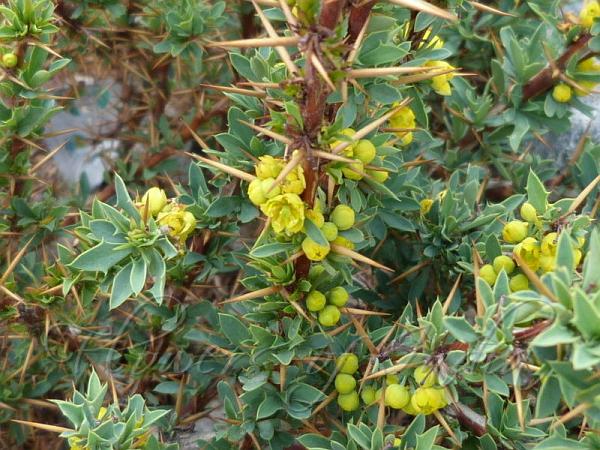|
| Gorse Barberry |
|

|

| File size | 163251 |
| Original date | 6/27/12 12:10 PM |
| Resolution | 800 x 600 |
| Flash | Flash did not fire, auto |
| Focal length | 4.5mm |
| Exposure time | 1/125s |
| Aperture | 2.8 |
| Focus Distance | |
| Metering Mode | Multi-segment |
| Camera make | Panasonic |
| Camera model | DMC-FZ40 |
| Sensor type | OneChipColorArea |
|
|
|
|
Photo: |
Botanical name: Berberis ulicina Family: Berberidaceae (Barberry family)
Gorse Barberry is a small hairless shrub, 1-2 m
tall, much branched and densely spiny with 5-10 mm long internodes and
reddish-brown stems. Spines are 3-pronged, 1-1.5 cm long. Leaves are
5-1.5 mm long, 2-4 mm broad, linear-lanceshaped or very narrowly
oblanceolate, often entire to 1-2-spinulose at the margin, green to
somewhat glaucous, minutely spine-tipped. Flowers are borne in
3-6-flowered, fascicled clusters hardly or not exceeding the leaves.
Flowers are 5 mm in diameter, orange-yellow. Flower-stalks are very
short, 2-4 mm long. Petals are slightly shorter than the inner sepals,
4-5 mm long, 2-3 mm broad, emarginate. Stamens are 3-3.5 mm long.
Ovules 3-5. Berries are spherical to ovoid, 4-6 mm long, blue to blackish.
Gorse Barberry is found on dry rocks in the Himalayas, in Kashmir,
Ladakh and Tibet, at altitudes of 2500-3700 m. Flowering: June-July.
Medicinal uses: Gorse Barberry is used in Jammu, Kashmir, and Ladakh to remedy ringworm,
as tonic, for throat problems, diarrhea, intestinal ulcers, lung diseases,
eye problems, piles, as tonic, for bloody vomit, and lung diseases.
Gorse Barberry is used in Jammu, Kashmir, and Ladakh to remedy ringworm,
as tonic, for throat problems, diarrhea, intestinal ulcers, lung diseases,
eye problems, piles, as tonic, for bloody vomit, and lung diseases.
Medicinal uses:
 Gorse Barberry is used in Jammu, Kashmir, and Ladakh to remedy ringworm,
as tonic, for throat problems, diarrhea, intestinal ulcers, lung diseases,
eye problems, piles, as tonic, for bloody vomit, and lung diseases.
Gorse Barberry is used in Jammu, Kashmir, and Ladakh to remedy ringworm,
as tonic, for throat problems, diarrhea, intestinal ulcers, lung diseases,
eye problems, piles, as tonic, for bloody vomit, and lung diseases.
| Identification credit: Tabish | Photographed in Nubra Valley, Ladakh. |
• Is this flower misidentified? If yes,